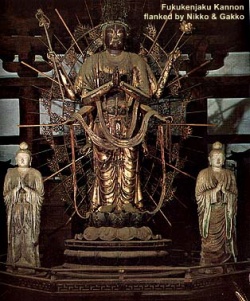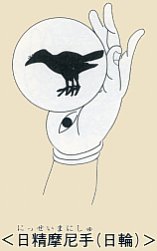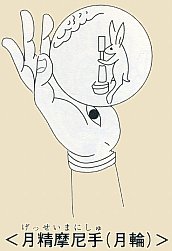Nikkō Bosatsu and Gakkō Bosatsu
Nikkō (Sunlight Bosatsu) & Gakkō (Moonlight Bosatsu)
Hindu Counterparts Nitten 日天 (Sūrya, Āditya) & (Gatten 月天 (Candra)
Siblings who serve the Yakushi Nyorai. Nikkō (Nikko) is the Bodhisattva of Sunlight (Solar Radiance) and Gakkō (Gakko) is the Bodhisattva of Moonlight (Lunar Radiance). They are sometimes depicted holding solar and lunar symbols, with Nikkō grasping a red solar disc 日輪 and Gakkō a white lunar disc 月輪. The two appear most frequently as kyōji 脇侍 (two attendants on either side of the central statue; sometimes pronounced "wakiji") to Yakushi Nyorai in a triad known as the Yakushi Sanzon 薬師三尊. Typically Nikkō is to the left and Gakkō to the right of the central statue. Less frequently, they are paired with Senju Kannon 千手観音 (as at Dōjōji Temple 道成寺 in Wakayama prefecture) or with Fukūkenjaku Kannon 不空羂索 (as at Tōdaiji Temple 東大寺 in Nara; . Nonetheless, it is difficult to tell the two apart, for differences in dress, placement (right or left of the main image), and iconography (inner or outer arms raised) are not always consistent in Japan.
One way to distinguish between the two is to look for the Nichirin symbol (日輪 = Sun Disc) or the Gachirin symbol (月輪 = Moon Disc). The Nichirin is a round circle, typically red in color, and held by Nikko. The circular sun disc is also used frequently as the halo for deities like Aizen Myo-o and Dainichi Nyorai. The moon disc, the Gachirin (also called Gatsurin or Getsurin), is a perfectly round circle, typically white, meant to represent the full moon, a frequently used symbol in Buddhist painting and sculpture. It represents the Buddha's knowledge and virtue and symbolizes the aspirations of sentient beings to attain Buddhahood. The Gachirin is a key attribute of Gakko Bosatsu, who is often shown in statues and paintings wearing a headpiece representing the moon or holding a circular form in the palm of his hand. In the Kongōkai Mandala 金剛界曼荼羅 of Esoteric Buddhism, moreover, each of the nine divinities is shown seated in the circle of a full moon. The Gachirin is also found often on Buddhist grave stones called Gorinto.
Mantra
Nikkō's Shingon Mantra (真言宗真言)
おん ろぼじゅた そわか
On Robojyuta Sowaka
also おん そりや はらばや そわか
Gakkō's Shingon Mantra (真言宗真言)
おん せんだら はらばや そわか
On Sendara Harabaya Sowaka
Nikko and Gakko at Todai-ji Temple, Nara

Although traditionally called Nikko and Gakko, these clay statues (746) may actually represent Brahma and Indra. They flank a large Fukukenjaku Kannon (see photo near bottom of this page) in the Sangatsu-do at Todai-ji. At 7 1/2 feet in height, the statues are larger than life size, although they are still dwarfed by the 12-foot high Kannon.
Nikko and Gakko usually appear as attendants of Yakushi Nyorai, but in the photo at right and below they attend the Fukukenjaku Kannon. It is difficult to distinguish between Nikko and Gakko, for their depictions in Japanese sculpture and art are inconsistent.
Differences in dress, placement (right or left of the main image), and stance (inner or outer arms raised) can lend clues to help identify the two, but such differences are not consistent.
For example, at Todai-ji, To-ji and Yakushi-ji, Nikko stands to the viewer's right, with Gakko positioned to the viewer's left. But at Kakuon-ji in Kamakura, Nikko is to the viewer's left while Gakko is positioned at the viewer's right.
The Fukukenjaku 不空羂索 (Fukūkenjaku) Kannon at Tōdaiji Temple 東大寺 in Nara stands 12 feet high. It dates to 746 AD and is made of dry lacquer. The Kannon is flanked by Nikko (to right of main statue) and Gakko (to left). This form of Kannon has eight arms. Fukukenjaku means "never empty lasso." It refers to the coil of rope which the Kannon holds in one of the lower arms (viewer's right). Kannon uses this rope to catch straying souls and lead them to salvation. The lasso is found in other multi-armed forms of Kannon as well.
Nichirin (sun disc) with a black three-legged crow drawn inside
In Japan, Nikkō Bosatsu is associated with a black three-legged crow, as are other deities including Myōken (the deification of the Pole Star and the Big Dipper), Emperor Jimmu 神武天皇 (Japan's legendary first emperor), and Nōjo Taishi 能除太子 (the founder of Haguro Shugendō). People with eye disease or poor eye sight in Japan can purchase talismans or icons called Nissei Manishu 日精摩尼手, which show the 3-legged bird inside the sun disc. Making proper pleas and prayers to the icon is said to cure one's eye problems. Let us recall that Myōken literally means "wonderous sight."
Why the three legs and why the black crow inside a sun disk? The most plausible reasons involve Chinese mythology and Japan's own creation legends. First, a black three-legged crow known in China as Sānzúwū 三足烏 (lit. = three-legged bird) appears in Chinese artwork dated to the Yǎngsháo 仰韶 period (5000 BC to 3000 BC). In Chinese mythology and ancient philosophical texts, this bird is intimately related to the sun. It has three legs, according to the Huáinánzǐ 淮南子(2nd century BC Chinese text), because three is the emblem of Yang -- and the supreme essence of Yang is the sun.
Second, in Japan's own creation myths, including the Nihon Shoki 日本書紀 (submitted to the Japanese imperial court in 720 AD), a giant crow called Yata-garasu 八咫烏 (eight-span crow) appeared to Japan's first emperor, Jimmu 神武天皇, who had landed on the shores of Japan but gotten lost. The crow was sent by Amaterasu Ōmikami 天照大神 (Japan's supreme sun goddess) to lead Jimmu to Yamato (the heartland of Japan). Says site contributor Cate Kodo Juno, an ordained Buddhist priest of Japan's Shingon sect: "Since the crow is also associated with Myōken and the Pole Star, could it be that it was the Pole Star that guided Jimmu?"
Third, according to Maison Franco-Japonaise (which translated the film Shugen: The Autumn Peak of Haguro Shugendō):
- "The founder of Haguro Shugendō is Nōjo Taishi 能除太子, who is said to have come to Haguro early in the seventh century. He was given the title of Shōken Daibosatsu 照見大菩薩 in the 19th century. Legend says he was the third son of the late sixth century emperor Sushun 崇峻天皇 (reigned 587 to 592), and the cousin of Shōtoku Taishi (574-622), Japan's first great patron of Buddhism. According to legend, prince Nōjo renounced his title and position, took the name Kōkai 弘海, and became a wandering hermit of the mountains. Nōjo is depicted as a strange being, dark of skin and with exaggerated facial features, his mouth extending from ear to ear. It was to a place called Akoya, in a narrow valley full of thick growth, with a waterfall at one end, that Nōjo was guided by a mystical three-legged crow, and it was here that he first did ascetic training. Here also he found a statue of Kannon Bosatsu and it was from here that he founded the three sacred mountains (Dewa Sanzan) as a Shugendō site." Site contributor Cate Kodo Juno offers another asute observation: "It is most likely that the story of Haguro Shugendō founder Nōjo Taishi is emulating the story of Emperor Jimmu, as often happens in hagiographies, in order to provide added legitimacy and authority to Nōjo's legend."
Some final words on the above Shugendō legend. Today people equate the three-legged bird with the three sacred mountains of Dewa Sanzan, but the basis of the legend goes back to earlier Chinese mythology. Also, Myōken, the deification of the Pole Star and Big Dipper, is a major star deity at sacred Mt. Haguro, one who is said to possess the power to cure eye diseases.
Gachirin (moon disc) with a rabbit pounding mochi (glutinous rice) drawn inside
In Japan, Gakkō is also associated with a hare. People suffering high temperatures or fevers can purchase such talismans or icons (called Gessei Manishu [[月精摩尼手), which are said to reduce fever and cool the body.
Why the rabbit? In the West, when people look at the moon, they see a man in it. The Chinese see a rabbit, pounding magical herbs to make the elixir of eternal life. The Japanese, with their love of obscure wordplays, envision the same rabbit pounding rice to make mochi. The name of the full moon is mochizuki, while mochitsuki means "making mochi."
The Rabbit is also associated with the Zodiac calendar.


